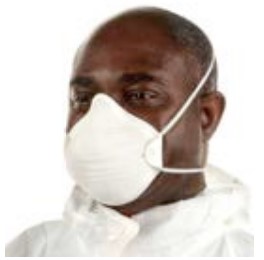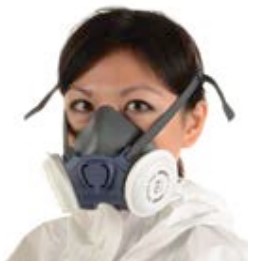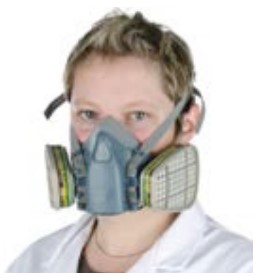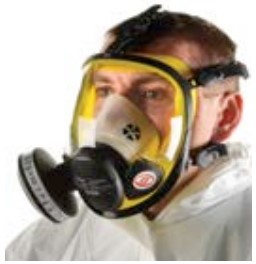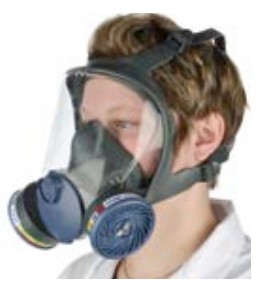 Many tasks, such as cutting and handling volatile substances, require respiratory protection in the form of respirators. Respirators are a form of Respiratory Protective Equipment (RPE) (the other being breathing apparatus) designed to protect operatives from such hazards in environments when sufficient oxygen is present. RPE should only be worn after you have taken all other reasonably practicable measures to prevent or control exposure. Respirators (or Filtering Devices), use filters to remove contaminants from the air. They can be unpowered, when the user breaths air through filter, or powered, when a motor passes air through filter. Respirators can be fitted with either a particle filter or a gas/vapour filter. Particle filters protect against fine sprays, mists and solid materials such as dusts/fibres/smokes and fumes; however, do not protect against gas/vapours. Likewise, gas/vapour filters do not protect against particles. Many tasks, such as cutting and handling volatile substances, require respiratory protection in the form of respirators. Respirators are a form of Respiratory Protective Equipment (RPE) (the other being breathing apparatus) designed to protect operatives from such hazards in environments when sufficient oxygen is present. RPE should only be worn after you have taken all other reasonably practicable measures to prevent or control exposure. Respirators (or Filtering Devices), use filters to remove contaminants from the air. They can be unpowered, when the user breaths air through filter, or powered, when a motor passes air through filter. Respirators can be fitted with either a particle filter or a gas/vapour filter. Particle filters protect against fine sprays, mists and solid materials such as dusts/fibres/smokes and fumes; however, do not protect against gas/vapours. Likewise, gas/vapour filters do not protect against particles.
HSE guidance states that when selecting RPE you must ensure that it is Adequate and Suitable for the task at hand. To be adequate the mask must be the right one for the hazard present and reduce its exposure level to the point that is required to protect the wearers health. To be suitable the mask should be the right mask for the wearer, task and environment. The mask should allow the operative to work freely and not add any additional risks.
Each RPE is categorised by an Assigned Protection Factor (APF). This is a rating which tells us how much protection the given RPE can provide. There are only six APFs used: 4, 10, 20, 40, 200 or 2000. An RPE with an APF of 10 will reduce the exposure by at least a factor of 10. The required APF should be in the safety data sheet or COSHH essentials, if this is not the case you can calculate the required APF using the working exposure limit (WEL) (found in EH40 Workplace Exposure Limits) and the quantity of the substance in the air (quantity of substance in the air measured taking exposure measurements in the workplace).
In some cases, more than one hazard and/or form of substance in your workplace will require the use of RPE and special consideration of the filter type is required in these cases. The following table provides information on British standards that certain respirators should conform too, what they protect against and their resultant APF given your choice of class/filter. You may find that you have more than one option to choose from |
|||||||||||||||||||||||

| You should bear in mind that individual models from various manufacturers may differ in style and detail, so always check the details with regards to BS standards when selecting RPE. You should cross-reference the posed risk with the level of protection that respirators provide. Again, you may find that you have more than one adequate and suitable option; in this situation the choice is yours and, therefore, factors such as cost and accessibility can be considered. Remember, you can also use equipment that provides higher protection than the minimum you need.
|
PPE is the last line of defence. When selecting PPE always ensure that first all other controls have been applied.
(All information correct as of January 2020)

